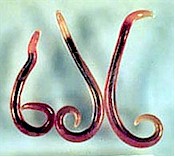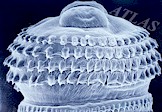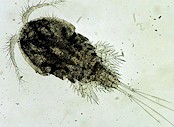Gnathostoma is a genus of parasitic roundworms pigs, dogs, cats and numerous wild animals worldwide, but are more abundant in tropical and subtropical regions of Asia (e.g. Thailand, Japan, China). It is also found in Africa, some European countries, South and North America (including parts of the US), and Australia.
pigs, dogs, cats and numerous wild animals worldwide, but are more abundant in tropical and subtropical regions of Asia (e.g. Thailand, Japan, China). It is also found in Africa, some European countries, South and North America (including parts of the US), and Australia.
The species most relevant for domestic animals are the following ones:
- Gnathostoma hispidum; affects pigs and wild boars in Europe, Asia and Africa. Wild boars are more affected than pigs.
- Gnathostoma procyonis; affects raccoons and occasionally cats.
- Gnathostoma spinigerum; affects dogs, cats, pigs and wild boars in Asia, Australia and America, mainly in hot and humid regions.
The disease caused by Gnathostoma worms is called gnathostomiasis.
Gnathostoma hispidum and Gnathostoma spinigerum can occasionally infect humans, who are not their final hosts, i.e. the larvae do not complete development to adult worms in humans. An unusual outbreak of human gnathostomiasis was recently reported in Mexico.
Are dogs, cats or pigs infected with Gnathostoma worms contagious for humans?
- NOT directly because the eggs of these worms shed by infected pigs or pets have first to be eaten by the intermediate hosts. But if the pigs or pets are infected, their environment will be contaminated as well, which makes it more likely for humans to become infected. For additional information read the chapter below on prevention and control.
You can find additional information in this site on the general biology of parasitic worms and/or roundworms.
Final location of Gnathostoma
Predilection site of adult Gnathostoma worms is the stomach. Migrating larvae can be found in many other organs (skin, liver, lungs, eyes, brain, etc.).
Anatomy of Gnathostoma

Adult Gnathostoma are medium-sized worms (10 to 50 mm long) and have a brownish to reddish color. The worm's body is covered with a cuticle, which is flexible but rather tough. Typical for Gnathostoma worms is that the cuticle is armed with spines all along the body.
Otherwise the worms have no external signs of segmentation. They have a tubular digestive system with two openings. They also have a nervous system but no excretory organs and no circulatory system, i.e. neither a heart nor blood vessels. Males have chitinous spicules for attaching to the female during copulation.
The eggs are rather large (40x70 micrometers), contain a single cell (i.e. they are not embryonated when shed), have an oval shape and one polar cap.
Life cycle of Gnathostoma

Gnathostoma worms have a complex indirect life cycle with dogs, cats, pigs and other carnivores as final hosts, microscopic crustaceans (Copepods) as first intermediate hosts (e.g. of the genus Cyclops, water fleas), and several vertebrates (e.g. fishes, snakes, frogs, etc.) as second intermediate hosts. In addition, birds, rodents, amphibians, snakes, and other vertebrates can also serve as transport hosts (=paratenic hosts).
Eggs shed with the feces of infested hosts release L1 larvae in water. Water fleas or related species eat these larvae, which complete development to L2 larvae inside these first intermediate hosts. Freshwater fishes, frogs or snakes eat these water fleas that release the L2 larvae. These L2 larvae continue development to L3 larvae and migrate into the flesh of the second intermediate host where they encyst.
When a final host (dog, cat, pig, etc.) eats a second intermediate host, the encysted larvae are released and either penetrate deeply into the stomach wall where they complete development to adult worms and reproduce, or they first undertake a migration through various organs (e.g. skin, liver, lungs, occasionally even eyes, spinal chord, brain, etc.) to finally come back to the stomach 3 to 6 months later. Larvae buried in the stomach wall cause the formation of tumor-like cysts filled with fluid and blood that may contain several adult worms. These cysts may remain connected with the lumen of the stomach or even with the peritoneal cavity through a fine canal.
Alternatively, a second intermediate host can be ingested by a transport host (birds, rodents, reptiles, etc.) where the encysted larvae do not complete development but wait until a final host eats the transport host. Such larvae often undertake migrations through various organs before becoming encysted again.
Harm caused by Gnathostoma, symptoms and diagnosis
In pigs, infections with a few worms are usually benign and cause no clinical signs. Massive infections can cause stomach inflammation (gastritis) that can lead to weight loss, and to delayed development in piglets.
In dogs and cats, Gnathostoma infections can cause gastritis and lack of appetite. In severe infections, the nodules in the stomach may burst and stomach content can leak into the abdominal cavity. This can cause a severe peritonitis (inflammation of the peritoneum) that can be fatal for the affected pet. Although not very common, migrating larvae can seriously damage various internal organs and cause specific symptoms related with the impaired functioning of the affected organs.
Gnathostoma worms can be seriously harmful for humans. Larvae migrating through the skin (cutaneous larva migrans) cause skin inflammation (dermatitis) that can be painful and itchy. Larvae migrating through internal organs (visceral larva migrans) will cause organ-specific symptoms. Fatalities are possible if such larvae get into the central nervous system.
Diagnosis in pigs, dogs and cats is based on the detection of eggs in the feces.
Prevention and control of Gnathostoma
In pigs
Gnathostoma infections are usually not a problem in industrial pig facilities, but can occur in pigs kept outdoors. In endemic regions, removing manure and keeping the facilities as dry as possible will reduce the incidence of Gnathostoma infections. Pigs should not be fed raw fish, chicken or other potentially contaminated hosts. Wild boars are usually the main reservoir and domestic pigs should be kept away from environments visited by such wild boars.
Most usual wormers for pigs are not approved for use against Gnathostoma worms. Some benzimidazoles (e.g. albendazole) and macrocyclic lactones (e.g. ivermectin) are effective against these worms, but not at the usual dose. Therefore the appropriate dose and treatment regime have to be determined by a veterinary doctor.
In dogs and cats
A frequent source of infection of dogs, cats and humans with Gnathostoma worms is the consumption of raw of insufficiently cooked fish (intermediate host), chicken or duck (transport hosts), which is quite usual in some Asian countries. In endemic regions this must be absolutely avoided. Fish must be boiled at least during 5 minutes to kill the larvae, or kept about 6 hours in a mixture of vinegar and acetic acid.
Although the eggs in the feces of infected dogs and cats are not directly contagious for humans, such eggs can contaminate ponds, fountains, pools, etc. that may contain water fleas or other small crustaceans that act as intermediate hosts. Dogs, cats and humans can acquire the infection if they drink such water contaminated with infected water fleas.
As for pigs, most usual wormers for pets are not approved for use against Gnathostoma worms. Some benzimidazoles (e.g. albendazole) and macrocyclic lactones (e.g. ivermectin) are effective against these worms, but the appropriate dose and treatment regime has to be determined by a a veterinary doctor.
There are so far no true vaccines against Gnathostoma worms, neither for livestock, nor for pets. To learn more about vaccines against parasites of livestock and pets click here.
Biological control of Gnathostoma worms (i.e. using its natural enemies) is so far not feasible. Learn more about biological control of worms.
You may be interested in an article in this site on medicinal plants against external and internal parasites.
Resistance of Gnathostoma worms to anthelmintics
So far there are no reports on resistance of Gnatosthoma worms to anthelmintics.
This means that if an anthelmintic fails to achieve the expected efficacy, chance is very high that either the product was unsuited for the control of Gnathostoma worms, or it was used incorrectly.
Learn more about parasite resistance and how it develops.
|
Ask your veterinary doctor! If available, follow more specific national or regional recommendations for Gnathostoma control. |